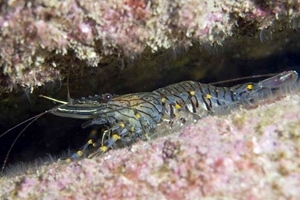Common prawn
 Many of us will have had prawns or shrimps from the sea on our dinner tables at some point, but the chances are it didn’t come from Britain. Have you met, or eaten, our own native common prawn, Palaemon serratus?
Many of us will have had prawns or shrimps from the sea on our dinner tables at some point, but the chances are it didn’t come from Britain. Have you met, or eaten, our own native common prawn, Palaemon serratus?
My grandad taught us how to go ‘prawning’ when we were little. It would be a special family evening out when the tide was very low and the moon was full. We’d climb up to the granary in the yard and fetch the push-nets, and drive down to the shore on a warm and calm late summer evening. I remember pushing my own little net over the rocks and weeds in the shallows, and bringing it up absolutely teeming with little silver and blue fish, crabs, mermaid’s purses and shells. And bouncing on top of it all, like hail off a pavement, were the prawns (usually tiddlers – everyone else got the big ones).
The common prawn inhabits weedy beds and stony crevices in the intertidal and shallow subtidal zones of the northeast Atlantic and Mediterranean. Along with many other species of prawns and shrimps in the sea, they are a vital part of the marine food chain, eaten by many fish. They are mostly scavengers themselves, feeding on detritus, algae, dead sea creatures and small benthic microorganisms, but they are predators too. They are stealthy, and can hear as well as a fish, which helps them track down smaller invertebrates amongst the rock and weed.
The common prawn is translucent, with brownish red stripes and bright yellow dots on its leg joints. Nigh-on invisible in water, a lucky prawn can live for 2-5 years and grow up to 11cm long.
If you have caught prawns, you will sympathise that they won’t go down without a fight. As much as I enjoyed the thrill of seeing prawns in my net, to a ten-year-old it is a terrifying challenge to seize a jumping prawn and get it safely in a cartridge bag without getting stabbed by the serrated spines on their snout (‘rostrum’). These are thought to help streamline the prawn when swimming, and the number of spines distinguishes them from their close relative, the rockpool prawn (Palaemon elegans).
Common prawns are seasonally migrant between the colder, deeper waters in winter, and the shallow warmer intertidal in summer. They are thought to be triggered by the lower salinity found inshore when the rainwater discharges from the coast are higher. With rainfall becoming increasingly unpredictable in both quantity and frequency these days, prawns and other species relying on this subtle sense might get confused, potentially impacting their lifecycle.
P. serratus is just one of several commercially important species of prawns and shrimps in the UK. The common prawn fishery is operated on a very local scale, comprising small fishing boats deploying pot traps or small trawls. We are a huge consumer of seafood, and yet, surprisingly, many of our common prawns are live exported to premium markets in southern Europe.
Meanwhile, we Brits have developed a taste for tropical farmed prawns with a colossal environmental price tag (usually the giant tiger prawn, Penaeus monodon), and most supermarket-sold coldwater prawns are of the Pandalus genus,imported from the western Atlantic and Pacific oceans, where the industry operates year-round. Perhaps our prawn fisheries could not keep up with demand and fell out of markets here, for many species are only available seasonally and susceptible to weather conditions, which can greatly reduce fishing effort and landings. With spotlights trained on food miles and sustainability, who knows whether there will be potential for our native common prawn to enter the local markets once again if the right processing and marketing infrastructure were in place. The same goes for a lot of ‘consumable’ native species of animals and plants, I suppose.
As a side note, though we use the terms for these stalk-eyed swimming crustaceans interchangeably, ‘prawns’ are taxonomically distinct from ‘shrimps’. You couldn’t tell apart similar-sized shelled and cooked specimens, but in life there are key differences in body shape, segments, leg claws and gills; and then you’ve got the freshwater/marine variations too. You never know when such trivia will come in handy…
Jess Brooks
Advisory
Photo credit: Sue Daly

Get Peter Thompson's essential 26-page book, featuring beautiful photography and detailed profiles of Britain's wildlife, for just £1.99.
Find out more >